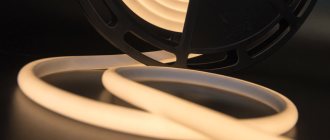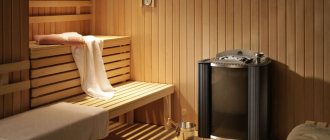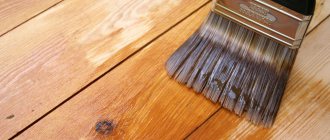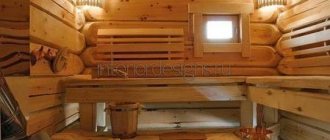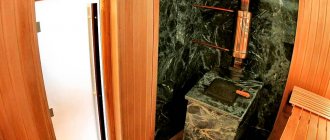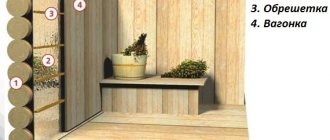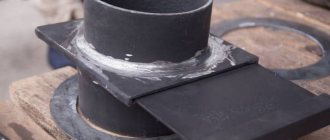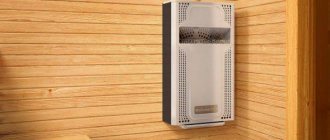Wood in a bathhouse will never lose its position, because, firstly, it is a traditional for bathhouses, and secondly, it is affordable (unless all the forests burn down). Therefore, it is worth systematizing the knowledge about the use of various lumber for baths and saunas, which is presented in the articles published on our website. In addition, lumber is not the only thing that can be made for a bathhouse from different types of wood; windows, doors, and furniture are discussed separately on our website. Follow the links - we always talk to the point, so there is something useful for everyone who has relevant questions.
Lumber for baths and saunas
First, let's find out what exactly can be used in a bathhouse or sauna. If the owner has chosen a wooden building, then it will be made of logs, and it can have either a cylindrical shape (rounded or natural trunk shape) or in the form of a beam (with a square or rectangular cross-section). This is wall material. Of course, in addition to this, you will need boards, beams and beams of various sections, which are involved in the formation of the roof, floor and other elements of the structure.
But even in a building made of brick or other materials, wood can be used. On the roof, on the ceiling and walls, on the floor, as well as for frames and doors, various lumber is used - boards, timber. Rafters, floor beams, sheathing, decking, joists, etc. are made from them. And, of course, clapboard cladding is a separate item.
Boards
A board is lumber whose width is significantly greater than its thickness. In cross section it is an elongated rectangle.
On sale you can find edged and unedged boards. Only the first ones have a section in the form of a rectangle, while for the second ones it is a trapezoid, because the upper plane is narrower than the lower one. Unedged boards are mainly sold with bark residue - wane.
ATTENTION! Wane is considered harmful because it is soft and easily harbors insects. However, they may not start, hence the denials of its harmfulness. We believe that it is worth deleting, but only if the designer does not say otherwise.
We devoted this article to finishing a bathhouse with unedged boards.
In addition to the edge, there are also important points - whoever wants a cheaper is better off taking an unplaned one. Planed boards have a smoother surface that only needs to be sanded. And if you take it unplaned, you will have to plan it yourself.
The same applies to humidity - boards with natural moisture will be cheaper than dried ones, but the buyer will have to provide them with the correct drying conditions (and at the same time be prepared for the fact that some of the boards will eventually be rejected due to warping).
Another factor is the type of wood. Any species of choice is used in the bath, but there are also recommendations - do not use conifers in the steam room, for example.
Resin leaks on coniferous wood
Pine is cheaper and makes good rafters, beams, joists, etc. Linden, aspen, alder and the like, more expensive ones, are perfect for finishing (precisely finishing) a steam room. That is, the sheathing can be made of pine, and the exterior trim and shelves can be made of hardwood.
By the way, if you are choosing boards for shelves, then useful information about their types and sizes can be obtained from this article.
This article will help you choose a floorboard
There is also an option to build a bathhouse entirely from boards . That is, use them as cladding for wall material. This is only possible if the bathhouse is framed, with insulation between the cladding boards. Read about how exactly such a bath is made here.
Wood generally needs treatment, but in a bathhouse it’s worth understanding what kind of treatment is permissible in a particular room, inside and outside in general. This article is devoted to the types of processing of boards in a bathhouse.
Lining
This is also a type of board, but we decided to separate it into a separate category. The fact is that lining is a very popular finishing option, so many questions arise in this regard, the most common of which we answer in our articles.
Of course, everyone wants to find out what the best and ask the price for it. We talk about which lining is worthy of that name in this article.
For those who have already made their choice in favor of inexpensive deciduous wood and are hesitating only between linden and aspen, we have collected the technical characteristics of both woods, compared them and suggest that they bet either on aesthetics or on the best performance. Read about it here.
Before you start laying the lining directly, you need to carry out insulation. Rarely is it not needed. And if in your case there is a need for it, check out the options we described in this material.
Let's move on to installation. How exactly is a bathhouse covered with clapboard? Read about it here. And if you just need to find out what fastening methods , what tools are needed for this, take a look at the article that separately examines fastening methods.
It only remains to mention that the lining is most often a thin board, which is easily moistened, and therefore is at risk of infection by fungi. You can increase its service life using the treatment we talk about in this article.
Log and timber
The thickness/diameter of these lumber varies widely - from 10 cm to an exclusive 40 or more.
The thinnest logs and beams are used either for the construction of buildings that are used only in the warm season, or for internal partitions. In the south of Russia, perhaps, an all-season bathhouse could be built from them.
BUT ! If you insulate a building made of thin logs or beams from the inside, you will get an analogue of a wall made of thicker logs.
The thickness usually recommended for the middle zone is 20 cm ; in more northern areas it is either insulated or thicker logs.
The log itself comes in two types - conical, where the butt part is thicker than the top part, or rounded, that is, it has been machined, bringing the log to the correct shape of a cylinder that is even along the entire length. The latter is more convenient for construction, but when processed, different layers appear on the surface, with different abilities to absorb moisture.
how to choose the best log for a sauna in this article.
The timber also has a different shape - square in cross-section or rectangular, profiled in parts that are joined during the construction of the wall or without a profile (necessary to prevent the formation of cracks, as well as the penetration of moisture). In addition, it can have convex front and back sides, or be straight.
Which of the available timber assortments is best suited for a bathhouse - read here.
If the timber has already been selected, and all that remains is to process and lay it in the wall, we recommend that you read this article before starting work.
BY THE WAY! Logs and beams are processed even before laying the wall begins. This may include treatment with an antiseptic and fire retardants. Treatment (impregnation) does not replace painting, but only precedes it. The material that will be used in the steam room can only be processed on the sides that are not visible in the steam room. The penetration depth is small, there is no cause for concern.
Dimensions
Of the three parameters - thickness, length and width - we will talk below about only one: thickness. This is the most important parameter, because the thickness of the boards on the ceiling in the bathhouse differs from the floorboards. The width can vary at the request of the owner, although even here there are conditional average values to which the majority tends. And the length is determined not by the length of the lumber, but by the length of the building section. where it will be applied.
Thickness for walls
Of course, here it would be better to distinguish the profiled board, which is called “lining,” from other boards that can also be used for interior cladding (for example, unedged).
That is, the walls can be finished inside and outside with boards. Sometimes even unedged. Inside they will be better fitted and sanded, outside they will be nailed in a herringbone pattern and perhaps only planed before.
Another option is the same lining inside. It is attached vertically or horizontally to the sheathing. At the same time, the thickness of ordinary lining can vary in the range from 12 to 40 mm , and eurolining has only three thickness options - 13, 16, 19 mm.
The thickness of edged or unedged boards that can be used to cover a bathhouse can be as follows: 16, 19, 22, 25 mm .
Ceiling thickness
Everything here is quite simple: even if you do not have a floor ceiling, but a false ceiling, you should not make the structure heavier for no particular reason. Therefore, the thickness of the boards on the ceiling in the bathhouse should be minimal, because we are talking about finishing, and not about what the floorboard will be like from the attic side.
Most often, if the walls are covered with clapboard, then the ceiling is finished with the same material.
If there is a desire to finish with unedged boards in two layers, 16-22 mm will be sufficient . There is no point in making them thicker - they will not provide a vapor barrier, there is a vapor barrier for that, the insulation also rests on a special heat insulator, so the ceiling boards are purely decorative.
Thickness for floor
If you focus on manufacturers of tongue and groove boards, then there is a standard pitch: 28, 30, 32, 35 and 40 mm. But the bathhouse owner has a wider choice than the manufacturer offers.
A tongue and groove board is good everywhere except in the washing room and steam room. As for these two rooms, most people prefer to make a poured floor, and in order for the board to serve longer, they use a thick edged board - 40-50 mm.
Of course, this is not the law. In fact, the thickness of the board depends on how far apart the joists or support posts . You can learn more about the relationship between the distance to the support points and the thickness of the board from this article.
Deciduous trees
Linden is considered to be the best deciduous wood for decoration. This wood at the same time retains heat perfectly, but also does not heat up too much, due to which the skin does not burn if you have to touch even very hot walls.
Linden has the property of releasing twice as much essential oils as other trees. Therefore, it is ideal for the body. And due to the fact that its vapors increase sweating and are hypoallergenic, the effect is enhanced.
Common aspen can be considered an excellent alternative for linden.
It has the same healing properties. Moreover, this tree also has the ability to change the mood to positive and calm. Aspen is not subject to rotting, and is very easy to work with due to the fact that its fibers are quite soft and docile.
Diagram of the structure and dimensions of the lining.
Ash and oak have approximately the same properties.
These are quite durable trees that are little susceptible to rotting and deformation when exposed to high temperatures, especially oak. They release less antiseptic into the air, but are quite good in practical terms. Over time, the oak slightly changes its shade to a darker one, but this does not spoil its appearance at all.
If you want the most practical and useful steam room, then it is better to trim some elements that are most susceptible to heating from oak or ash. After all, ash and oak, despite the fact that they are resistant, tend to get very hot. Remember that ash needs to be treated more carefully with special means, as the risk of fungus is slightly higher.
Another excellent type of wood for finishing a steam room is white acacia. If it is properly pretreated, acacia can surpass oak in its strength and resistance to deformation. Due to the fact that acacia boards are less common, it is advisable to use them to decorate the bathhouse floor, since it is more susceptible to impacts.
Where are we
- 8
- [email protected]
- Main office:
Moscow, Nakhimovsky prospect, 24, VK Expostroy, hall No. 3, row 11, place 367
Operating mode:
Monday - Saturday from 10 to 20, Sunday from 10 to 19
- Trade pavilion:
Construction fair "MILL" 41 km MKAD, Pavilion NB-33
Operating mode:
Monday - Sunday from 9 to 18
Additional Phone:
8
Is the price of abash worth the candle?
Extra shelves are sold on the market from 2 meters. Consumers look at the variety, and then pay attention to the cost. The price difference can be more than 50%. Starting price - 535 rubles per m.p. Extra wooden blanks are sold in lengths of 1.8 meters. They already cost 600 rubles. In Africa, Extra 2.2 meters is offered. Starting price from 620 rubles. Extra 2.8 meters is the most expensive. In terms of cost, it even outperforms mahogany. Manufacturers ask 700 rubles for one linear meter.
African tree myths about abasha
An abasha sauna in the 20th century does not seem outlandish. There are many myths surrounding the material. Abacha is really picky about his tools. This means that there are subtleties of processing and this is true. It is said that abash can only be bought in elite stores. Now the material has become common, and the cost is also different. For abashi for baths, the price depends on the type. There is also a problem with counterfeits. The next myth is related to the disgusting smell.
Users are looking for a tree for a bath that does not heat up. In fact, the material has permissible temperature limits. The smell does appear, but it cannot be called disgusting.
Video description
For interesting ideas for interior decoration of a bathhouse, watch the video:
Decorating a relaxation room in a bathhouse, in addition to traditional wood, can be done:
- glass wallpaper;
- porcelain stoneware;
- natural stone;
- decorative plaster.
Important! The tree is not installed immediately after delivery to the construction site. It is brought into the room and allowed to stand for a couple of days so that it “gets comfortable” in the bathhouse. After this procedure, the wood is not subject to deformation when heated and high humidity.
Beware fake
The abashi board may not live up to expectations, since there is Asian imitation on the market. It is difficult to determine by external indicators, but there is a difference in smell. If you are considering an abash board for a bath, the price should start from 500 rubles. per linear meter. If the cost is less and more significant, it is definitely not triplochiton. Abash wood for a bath should be hard resin. This means that at high temperatures they retain their original properties. You can check with the seller for information regarding the fastening. If he says that a given sauna heater adheres remarkably well to nails, it’s a fake.
True connoisseurs of quality wood should be interested in silk wood. Only it is famous for its excellent characteristics, and over time it will not appear yellow.
What type of boards to choose
All boards are divided into certain types and have their own characteristics. It is worth noting that not every type of board is suitable for the complete design of a bath; below are the types and brief recommendations for their use in a bath:
- Edged and unedged boards can be used as interior and exterior decoration. Unedged boards are most used as decoration to give the interior an ethnic style.
- Tongue and groove boards have tongues and grooves, which creates a lock that does not contribute to the appearance of cracks and water does not leak through them. As a rule, boards of this type are used to decorate a relaxation room or to create a dry floor in a steam room.
- Deck board is the best option for covering the floor in a bathhouse. This material is not afraid of high humidity and temperature changes, durable and reliable in use. The deck board can be without or with relief on the front sides, which gives it a more original look.
- The decking board has a characteristic relief on the front side in the form of a longitudinal notch. Due to this notch, this material is absolutely non-slip - an excellent option for flooring in a steam room.
Overview of types of wood for finishing a steam room
Today, two main materials used for finishing baths are block house and lining. But even they come from different wood species that have different properties. The best species for a bath are linden, larch, aspen, ash, oak, white acacia, spruce, pine and cedar.
Figure 2.
Installation diagram of a block house. Many wood experts constantly argue with each other which species are better to choose: deciduous or coniferous. On the one hand, coniferous trees are good because they do not change their color over time, so they always remain in this form, in which were originally during installation. On the other hand, hardwoods are considered more resistant to temperature fluctuations and high levels of humidity. But both of them have their own characteristics.
general characteristics
Now it has become easier to buy abash in Moscow, the characteristics of the material are known:
— compressive density over 200 N;
— shrinkage up to 12%;
— length up to 4 m;
— tensile strength up to 450 K;
— width from 60 mm.
Abash lining price differs from compression density. The second point is shrinkage, which depends on the variety. Next, tensile strength is important for the buyer. There are differences depending on the place of origin of the tree. Width and length are standard for all regions.
View this publication on Instagram
Publication from Construction of baths and saunas (@firecompro)
Setting up a dressing room
The main function of the dressing room is to preserve heat. The temperature in the room is not high, so it is good to use coniferous trees to decorate walls in a traditional style.
Design of the waiting room and rest room “under the tree” Source koon.ru
The interior decoration of the bathhouse made of logs creates an atmosphere of antiquity and ancient fairy tales. A light aroma created by pine, fir, and spruce is appropriate here. The wood of these species resists fungus and mold well. It does not crack after drying and is durable. When heated, fir releases almost no resin.
If hardwood is preferred, experts advise finishing the room with birch. The lining can be laid out not only in even rows, but also in a pattern. It is important that the walls in the room are covered with the same type of wood.
Interior arrangement of the steam room
As a rule, benches, shelves, and headrests are installed in the steam room. They are fairly easy to make, so you can do it yourself. It is recommended to make bath furniture from the same type of wood that was used to cover the walls of the steam room.
Nowadays African oak, or abashi in other words, has become widespread.
It has such advantages as:
- low thermal conductivity;
- moisture resistance;
- high density;
- durability;
- strength;
- does not deform;
- pleasant to the touch.
The disadvantage of abashi is its rather high price.
What to hammer in: nails, screws or staples?
The lining itself is a board with a certain profile, which must have a tongue-and-groove locking connection. It is attached to the wall or ceiling using nails, screws or staples. The tools and material required to hammer in the lining in the bathhouse are as follows:
- nails, screws, staples;
- hammer, screwdriver, hardware gun;
- a mallet or a piece of clapboard for knocking a tenon into a groove;
- building level.
What nails should I take for the lining in the bathhouse? It is desirable that these are finishing nails 30-40 mm long, with an anti-corrosion coating. It’s worth taking coated screws (their length is the same, by the way). Regarding the length, you should proceed from the thickness of the board (if in a groove, then only the walls of the groove), plus you need to punch through the block to which the board is attached at least to the middle.
The staples should be the same size, although there are comrades who nail 14-mm staples with a construction stapler through a clamp, but this is rather an exception. To properly line a bathhouse with clapboard, it is better to use long staples and shoot them at an angle of 45 degrees (approximately).
Of course, it is tempting to wonder which of these methods is better. There cannot be a definite answer to this, because everything depends on the experience of a particular person. And if it is not there, then the easiest thing to do is to shoot the staples using a pneumatic gun. True, it is not cheap, and few people would agree to buy it for a one-time job. Other methods are a little more difficult to implement.
What can be found on sale
If you visit a store and choose a thermal abash, it turns out that you can do different things with it:
— lining;
- shelves abash.
There are differences in properties and price, so it makes sense to analyze each option separately.
Lining
Abash wood for a bathhouse, the price can be confusing. But the lining in the store is cheaper than the shelves. Abash wood for baths is divided into classes. Each species has individual characteristics. If you buy a thermocouple for your home, it is important to check the degree of processing. Different grades entail responsibilities for further processing and preservation of the material.
For abash, the price may be inflated due to individual sizes. Standard widths are 80, 85, 90, 95. Abash boards are also made to order. It can be with or without a thorn.
shelves
When the price of the abash for a bath is known, it’s worth moving on to the properties. Shelves are always sold processed. This material is ideal for cladding. African abash has standard sizes (width 80, 90 mm). If we consider the custom option, it can be 40-70 mm. It’s easier to buy a long-length abash for a bath. The maximum to date is 4 meters.
